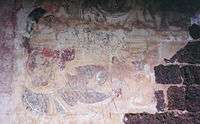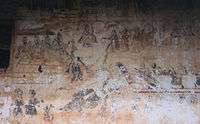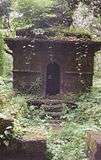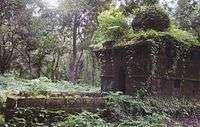Shri Dev Rameshwar Temple
| Shri Dev Rameshwar Temple | |
|---|---|
|
Shri Dev Rameshwar Idol | |
| Name | |
| Proper name | Shri Dev Rameshwar Mandir |
| Devanagari | श्री देव रामेश्वर मंदिर |
| Geography | |
| Country | India |
| State | Maharashtra |
| District | Sindhudurg |
| Location | Rameshwar Wadi |
| Culture | |
| Primary deity | Lord Rameshwar (Lord Shiva) |
| Important festivals | Mahashivratri |
| Architecture | |
| Number of temples | 1 |
| History and governance | |
| Date built | 16th Century |
| Website |
www |
Shri Dev Rameshwar Temple is located in village Rameshwar Wadi in Devgad taluka of Sindhudurg District, Maharashtra, India. This temple is dedicated to the Hindu deity Lord Shiva.[1] It is a historic temple built in 16th century. Its chief interest is the approach about 250 yards long, cut through rock fifty feet deep. The idol, a four-armed figure seated on a bull, is of solid silver said to weigh a hundred kilograms and is in good condition at present.[2]
Architecture
.jpg)

The architectural patterns of the temple building shows that it has been expanded at least three times from its establishment until now. In the early 18th century, Sarkhel Kanhoji Angre built a quadrangular inner shrine made up of finely hewn stones, also called as the Gabhara around the original place of Lord Shiva's pindi. This is the main room of the temple which contains a shivling or pindi at its centre. Later, in the mid 18th century, Sardar Sambhaji Angre and Sankhoji Angre built a Mandap in front of the gabhara. This mandap consisted of four huge wooden pillars bearing beautiful carvings all over them. They also built a Pradakshina Marg around the gabhara. The entire area was enclosed with walls to form a small temple consisting of the gabhara, the mandap and pradakshina Marg. The entire temple building covers an area of 4,025 sq ft. Stone tiles were placed in the area outside the main temple building covering an area of about 15,000 sq ft. It was in this era that the temple was provided with two new gates on the western and southern side.

In 1763, Shrimant Madhavrao Peshwe appointed Anandrao Dhulap as the chief of the Maratha Navy. Anandrao was also appointed as the governor of Vijaydurg Fort. In 1775, Madhavrao Peshwe appointed Gangadhar Bhanu as the Subhedar of Vijaydurg region. In 1780, Subhedar Gangadhar Bhanu built a huge Sabha Mandap with 20 carved wooden pillars.[2] Early 18th century showed lots of changes and developments in the structures, architectures and the surrounding area of the temple. The most notable change was made by Sardar Anandrao Dhulap. He built two additional gates on the northern and eastern side of the temple. The eastern gate was built by making a way or Ghati by cutting a small hill adjoining the temple on the eastern side. He also built the main entrance or the Mukhya Pravesh Dwar for the temple. A huge bell hangs on the eastern gate which has year 1791 engraved on it. This bell was the one that was brought from the Portuguese Ship which was captured by the Maratha Navy. The main wooden mast of this ship has been installed in front of the Main entrance of the temple at the beginning of the Temple Ghati.
Mahashivratri Fair
A fair is held for six days in the month of Magha every year which is attended by about 5,000 people from nearby villages and towns.[2] The fair starts 5 days before the day of worship. On the Mahashivratri day, devotees observe fast and stay awake all night. Mahashivratri marks the night when Lord Shiva performed the 'Tandava'. It is also believed that on this day Lord Shiva was married to Parvati Ma. On this day Shiva devotees observe fast and offer fruits, flowers and Bael leaves on Shiva Linga.[3]
Wall Paintings
The walls of the temple show drawings depicting incidences from Ramayana and Mahabharata. These drawings were drawn by artists appointed by Sardar Sambhaji Angre. These drawings are unique in the sense that although they depict stories from the ancient vedic culture, the characters' clothes, weapons, ornaments and other equipments and instruments are similar to those found in the 18th century.[1]
| Images showing wall paintings on the temple building | ||||||
|---|---|---|---|---|---|---|
|
Administration
The management of the temple at present rests with trustees five in number, appointed by the Civil Court in 1914. The temple and its welfare is looked after by Shri Dev Rameshwar Devasthan Vishwasta Mandal and Rameshwar Vikas Mandal, Mumbai.[4] This Devasthan holds inam land and also a cash allowance of Rs. 334 per year from Government.[5] The trustees have repaired the temple from time to time since 1914. The temple at present is in good condition and is being renovated.[1]
Sarkhel Sambhaji Angre Samadhi
A tomb (samadhi) of Sarkhel Sambhaji Angre is located just outside the Southern gate of the temple premises. It is made up of stones and is around 200–250 years old. Along with him, seven small stones have also been places inside the tomb as well as outside it representing his wives.
| Sarkhel Sambhaji Angre Samadhi | ||||
|---|---|---|---|---|
|
Official Website
The official temple website is shridevrameshwar.org. This site is managed by Green Earth Web Developers, Mumbai[6][7] under the guidance of the temple management. The site provides important links to blogs,[8] encyclopaedic articles, images and more contact information regarding the temple. It also hosts a number of places of interest in the surrounding region. The list of members which form the 3 different committees of the temple management is also provided.[9] Over a period of few years there have been lots of donations for the development and refurbishment of the temple.[8] The list of these donors is also available on the official website of the temple.[10]
See also
- Alphonso (mango)
- Kanhoji Angre
- Pujare (clan)
- Rameshwar Wadi
- Vijaydurg (city)
- Vijaydurg Fort
- Rameshwar Dockyard
References
- 1 2 3 Official Blog for Shri Dev Rameshwar Temple
- 1 2 3 The Gazetteer of Ratnagiri - Places of Interest (Vijaydurg)
- ↑ Society for the Comfluence of Festivals in India
- ↑ Shri Dev Rameshwar Official Booklet
- ↑ Official Blog - Pujare Clan
- ↑ Green Earth Web Developers
- ↑ "Web Designing". greenearth.firm.in. Retrieved 2015-12-09.
- 1 2 shridevrameshwar.org - Blog Page
- ↑ shridevrameshwar.org - Members Page
- ↑ "Blog | Shri Dev Rameshwar". shridevrameshwar.org. Retrieved 2015-12-09.



.jpg)

